Angela Ackerman's Blog: Writers Helping Writers, page 52
April 16, 2022
Fear Thesaurus Entry: Abandonment
Debilitating fears are a problem for everyone, an unfortunate part of the human experience. Whether they’re a result of learned behavior as a child, are related to a mental illness, or stem from a past wounding event, these fears influence a character’s behaviors, habits, beliefs, and personality traits. The compulsion to avoid what they fear will drive characters away from certain people, events, and situations and hold them back in life.
In your story, this primary fear (or group of fears) will constantly challenge the goal the character is pursuing, tempting them to retreat, settle, and give up on what they want most. Because this fear must be addressed for them to achieve success, balance, and fulfillment, it plays a pivotal part in both character arc and the overall story.
This thesaurus explores the various fears that might be plaguing your character. Use it to understand and utilize fears to fully develop your characters and steer them through their story arc. Please note that this isn’t a self-diagnosis tool. Fears are common in the real world, and while we may at times share similar tendencies as characters, the entry below is for fiction writing purposes only.
 Fear of Abandonment
Fear of AbandonmentNotes
While death and loss are a part of life, they’re incredibly difficult to deal with. Being left behind (whether the leaving is voluntary or a choice) by someone important is something that many people and characters can worry about, even to the point of it becoming a fear that takes over their life.
This is one of the worst feelings to experience and it can be inflicted by anyone close to the character���a family member (parent, spouse, sibling, child), lover or romantic interest, best friend, mentor, etc. Someone who has experienced abandonment may develop a debilitating fear of it occurring again, but so can people who have never gone through it because they know the anguish it causes and don’t want it to happen to them.
Whether it looks like guardedness or holding on too tightly, a fear of abandonment can manifest in a number of ways.
What It Looks Like
Maintaining shallow relationships (so the character never grows close to someone who could leave them)
Reluctance to fully commit to a relationship
Sabotaging promising relationships by pushing the other person away, treating them badly, cheating on them, abandoning them first, etc.
Believing that people are going to leave (due to insecurity, feeling unworthy of love, etc.)
Difficulty trusting others
Becoming possessive or manipulative as a way of controlling the other person and keeping them from close
Staying in an unhealthy relationship because the character believes it’s better than being alone
Attaching too quickly to a partner, friend, etc.
Seeking frequent reassurance of the other person’s loyalty or love
Making demands of the other party that will “prove” their love or loyalty
Separation anxiety
Being extremely sensitive to criticism
Seeking to please and appease
Struggling with emotional intimacy
Reading too much into the other person’s words or actions
Common Internal Struggles
The character blaming themselves for things that aren’t their fault
Struggling with anxiety or depression
Being tempted to do something they don’t want to to keep the other party happy
Feeling worthless or unlovable
The character wondering what’s wrong with them (that causes people to leave)
Wanting reassurance from the other person but not wanting to come off as clingy or desperate
Feeling defective and unfixable
Worrying that they will never be happy
Hindrances and Disruptions to the Character’s Life
Having many shallow relationships and few deep, meaningful ones
Struggling to engage with new people because the character is too afraid
Getting stuck in a cycle of not wanting to be abandoned but constantly exhibiting behaviors that drive people away
The character losing sight of who they are because they’re so eager to become the kind of person their partner will stay with
Having to explain to others why the latest relationship didn’t work
Living in denial about what’s really happening
Scenarios That Might Awaken This Fear
Being asked out by someone
A romantic relationship moving to a new level of commitment (becoming exclusive, moving in together, getting married, etc.)
A move that will require the character to start and develop new relationships
A friend not returning a phone call, showing irritation, or doing something else the character perceives as withdrawal
Experiencing the unexpected death of a parent, spouse, or other close loved one
Being selected as one of the people at work who will be laid off
Other Fear Thesaurus entries can be found here.
 Need More Descriptive Help?
Need More Descriptive Help?While this thesaurus is still being developed, the rest of our descriptive collection (16 unique thesauri and growing) is accessible through the One Stop for Writers THESAURUS database.
If you like, swing by and check out the video walkthrough for this site, and then give our Free Trial a spin.
The post Fear Thesaurus Entry: Abandonment appeared first on WRITERS HELPING WRITERS��.
April 14, 2022
Six Tips for How to Write a Compelling Action Scene

By Emily Young
Did you know that when you read a novel, your brain thinks you’re experiencing the events? ���The brain, it seems, does not make much of a distinction between reading about an experience and encountering it in real life,��� according to this article in The New York Times. No wonder we are hooked by action sequences. We think we are literally fighting for our own lives!
But this only works if the scene is well written. As an editor and writer specializing in speculative fiction, I am constantly reading, editing, and thinking about action scenes. They may be a blast to read, but they can be one of the trickiest sequences to write. These six tips can help you write more compelling action scenes.
Tip one: Ask your character what they want.Before your character grabs their long sword and plunges into the fray, tap them on the shoulder and ask, “Wait! What do you want?”
I���m serious. Writing a dialogue between yourself and your character can be so insightful ��� particularly when you’re trying to get deeper into their desire. (You can read more about this freewriting technique in this interview.) Your character might say something like, ���I want to win this battle!��� But everyone wants to win a battle. What we want to know is what makes your character unique in the situation. Why do they, particularly, have to get out of this fight alive?
Pretend you���re a journalist and probe deeper. Ask:
Why do you want to win?What will you do if you win this battle?What people in your life are you worried about right now?Who or what is standing in your way?Once you know what your character wants, you’ll have a better idea of what’s at stake ��� what they stand to lose ��� if this scene doesn’t play out the way they hope.
Tip two: Know how the scene will change your character.Often, an action scene looks cool, but has no emotional meaning. Try to avoid this pitfall. The physical events in this scene should be pushing your character to have an emotional change.
Ask yourself:
Why does this event need to happen to your main character?How will their perspective shift?What decision are they going to make at the end of the scene that propels them into the next scene?In an action-packed scene in Maggie Stiefvater���s The Dream Thieves, a pair of teenage friends fight off a monstrous bird creature. What gives the scene emotional depth is how it changes their friendship.
When the scene begins, the narrator, Gansey, is confused and frightened by his longtime pal: “When Ronan turned, his eyes were shuttered and barred. His hands were also coated in blood. Gansey had a pure, logicless moment where his stomach dropped and he thought, I don’t know who any of my friends really are” (page 134, hardcover edition). This is what is at stake, emotionally: Will Gansey actually get to know who his best friend is?
By the end of the scene, we have our answer. Gansey discovers that Ronan created this monster from his own dreams. This is a huge moment of vulnerability, which changes the arc of their friendship by bringing them closer together.
Tip three: Use a mini “arc” to plot your scene.You know what your character wants and what���s at stake if they lose. You understand how this scene will help your character to change emotionally. But how do you maintain tension? By using the principles of structure.
Every action scene has a beginning, middle, and end, just like your novel. Let���s go back to the monster fight in The Dream Thieves (pages 136-140, hardcover edition):
The inciting incident is the moment Ronan tells his friend something escaped from his dream.The tension builds. Take a look at these sensory details, which tell us something dangerous is about to happen: “The door to Ronan’s room was closed. A bookshelf had been emptied, tipped on its side, and pushed in front of it. The books were hastily piled beside the knocked-over telescope. Everything was silent and gray as the rain beaded on the windows. The smell Gansey had noticed downstairs was more prominent up here: moldy, sweet.”The action and intensity skyrocket from here, as the two boys scuffle with the monster.The scene reaches an all-is-lost moment in which Gansey thinks his best friend might be dead: “The thing made no sound as it reared back. Ronan swung again with the crowbar, and when it glanced off the creature, he aimed a fist instead. The two of them stumbled over the corner of the bed. The nightmare was on top of Ronan. Both of them fought soundlessly; Ronan could die, and Gansey wouldn���t know it until after.”The heroes make one last valiant effort, and they win the fight: “Then it was over, and Ronan unhooked the claw carefully from Gansey���s skin.”Make a ���scene chart��� for yourself. Fill in the answers to these questions:
What���s the inciting incident?How does the tension build?What are the action beats?What is the ���all is lost��� moment?How does the hero win or lose? Tip four: Get ready for actionHow do you write those action beats we just mentioned? Here are some ways you can master action choreography:
 Take a self-defense or martial arts class. Even if you can’t afford a full course, you can probably drop into a free session. Some courses are offered online during the pandemic.Read self-defense and survival books.Enlist your housemates in a mock battle.Map out your scene with action figures.
Take a self-defense or martial arts class. Even if you can’t afford a full course, you can probably drop into a free session. Some courses are offered online during the pandemic.Read self-defense and survival books.Enlist your housemates in a mock battle.Map out your scene with action figures.Remember, you don���t need to put every detail in your action scene. The reader doesn’t need to know everything that happens ��� they just need to know the moments of action that raise the stakes or give us important context.
For more action scene advice, be sure to check out this podcast on writing action scenes that slay.
Tip five: Get deep into your character���s POV.When you’re drafting this action scene, ask yourself what your main character would actually be paying attention to in this moment.
How do you immerse us in a character���s POV?
Use metaphors.Give us sensory details.Use sentence structure to change the pace. Short, choppy sentences mimic the fragmented experience of someone fighting for their life. Long, flowing sentences might show a sense of disorientation.Remove ���filtering��� words and phrases like ���she saw, she heard, she felt.��� Instead of saying, ���She felt a hand punch her,��� just say, ���A hand punched her.���Embrace the techniques of deep POV.Let���s take a peek at this moment from Daniel Woodrell���s literary noir novel Winter���s Bone. In this scene, the protagonist, Ree, is being attacked by a group of women for asking too many questions about her father���s death: ���The other women closed in with boots to the shins while more heavy whacks landed and Ree felt her joints unglue, become loose, and she was draining somehow, draining to the dirt, while black wings flying angles crossed her mind, and there were the mutters of beasts uncaged from women and she was sunk to a moaning place, kicked into silence��� (page 129-130, paperback edition).
Notice those metaphors? Killer.
Tip six: Revise.Your first draft might be dry and technical or messy and confusing. That’s normal! Action scenes take lots of time. In revision, you’ll probably have to do multiple passes. Be patient, and reward yourself each step of the way. Remember that we are always here for you at Writers Helping Writers!

Emily Young is a fiction editor with Angelella Editorial. She holds an M.F.A. from the Vermont College of Fine Arts Writing for Children and Young Adults program and attended the Tin House Young Adult Fiction Workshop in Spring 2021.
When evaluating a story, Emily focuses deeply on character. In her opinion, almost every part of the manuscript ��� from sentence-level flow to big-picture structure ��� can be improved by delving into the authentic emotions of your characters. Her favorite stories are science fiction and fantasy novels that pay as much attention to their characters��� journeys and internal growth as to the external adventures. You can follow her on Twitter at @egywrites or connect with her at Angelella Editorial.
The post Six Tips for How to Write a Compelling Action Scene appeared first on WRITERS HELPING WRITERS��.
April 12, 2022
What is Rhythmic Writing?
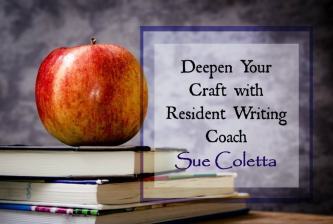
By Sue Coletta
Rhythm is one of the most underrated aspects of writing, but readers sense the rhythm in our words, whether they realize it or not. Rhythm attracts readers to certain authors.
Life itself has a rhythm.Whether it���s our heartbeat or the motion of the sun, moon, and planets, we���re embedded within a rhythmic world. Hence why rhythm has such enormous power. It���s built into who we are.
Have you ever lounged on a blanket outside at night, stargazing? Nature is never silent. Even a quiet evening has a melodic undercurrent ��� a pulse, if you will.
The same holds true in writing.
Rhythm Defines a MoodRhythm forces the reader to either rush through the pages, flipping one after another, or nestle in the comfy chair to quietly enjoy the story. Words dance. The writer who pays attention to story rhythm creates sentences that waltz, jerk, tango, stutter, tap dance, float, and sing.
Good writing ebbs and flows by varying sentences, paragraphs, and chapter length and structure.
Notice the atmosphere Hemingway creates in Farewell to Arms.
In the late summer of that year we lived in a house in a village that looked across the river and the plain to the mountains. In the bed of the river there were pebbles and boulders, dry and white in the sun, and the water was clear and swiftly moving and blue in the channels. Troops went by the house and down the road and the dust they raised powdered the leaves of the trees. The trunks of the trees too were dusty and the leaves fell early that year and we saw the troops marching along the road and the dust rising and leaves, stirred by the breeze, falling and the soldiers marching and afterward the road bare and white except for the leaves.
Rhythm Defines Pace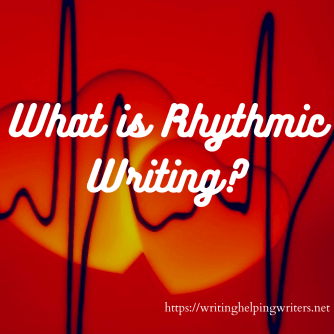
In music, tone length and dramatic pauses define rhythm. When long notes blend without pauses, the music flows like a swan across still water. On the flipside, short notes with clear pauses draw your attention. The music amps you up.
The same principles apply to writing. Rhythmic writing is defined by punctuation and the stress patterns of words. As a general rule, long sentences are more relaxing, while staccato sentences startle the reader. They draw attention. They force the reader to pay attention.
Run. Now.
Tension builds and releases. When a movie reaches its climax, the rhythm increases in pace only to subside as the story resolves. Within the larger rhythmic structure of a story, micro-structures also generate rhythm. Scenes change and plots twist. An interruption in the rhythmic flow transports the reader in a new direction. It knocks them off balance ��� a gentle slap to ensure they���ll keep flipping pages.
Sentence StructureIf each sentence follows the same structure and rhythm, the writing becomes boring and predictable. Writers who play with rhythm can create tension in many ways, depending on punctuation and word choice.
In the following example, notice how the intentional repetition of hard -ed verbs create tension in The Killing Song by PJ Parrish
He watched her for the next hour. Watched her playing with the plastic snow globe she had picked up in the souvenir shop. Watched her finish her peach tart, tuck her Fodor���s in her purse and wind the red scarf around her slender white neck.
In the next sentence, the authors slow the pace by varying the sentence structure, adding gerunds, and visceral detail, yet maintain the creepy atmosphere.
In the crowded elevator traveling down from the restaurant in the Eiffel Tower, he stood behind her, closing his eyes as he breathed in the grassy scent of her hair.
In White Fang by Jack London, note where he forces the reader to pause.
A vast silence reigned over the land. The land itself was a desolation, lifeless, without movement, so lone and cold that the spirit of it was not even that of sadness.
London also uses repetition but not with a hard -ed verb.
There was a hint in it of laughter, but of a laughter more terrible than any sadness ��� a laughter that was mirthless as the smile of the Sphinx, a laughter cold as the frost and partaking of the grimness of infallibility. It was the masterful and incommunicable wisdom of eternity laughing at the futility of life and the effort of life. It was the Wild, the savage, frozen-hearted Northland Wild.
Does Point-of-View Matter?Not at all. Using rhythm as a literary device isn���t limited to 1st or 3rd POV, or even past or present tense. Check out the melodic rhythm in Try Darkness by James Scott Bell. The novel is written in 1st POV, but the following excerpt is in 2nd POV to show the protagonist talking to himself.
And then you wonder what makes you go on, what makes you care, because it���s in there somewhere, the caring, even if you don���t know why, even if you don���t know any reason for it. It���s just there and that���s why you don���t sleep.
You look out at the dark, you walk around in it, you think maybe there���ll be a big insight, a sudden realization. And then everything will add up. That���s the hope part, the part the absurdists call a fool���s game.
Are you just a fool like everybody else?
You think of the girl and you think of her being scared and you can���t stand it, and caring becomes torture.
If God was in the room right now you���d scream at him.
That���s what you think about when you can���t sleep.
Next time you read a novel, pay attention to its story rhythm. Where does the author let you pause? How does the author vary long and short sentences? How does the writing ebb and flow? Do you notice a similar rhythm in the writing of your favorite authors?
Do you pay attention to rhythm in your writing? Sue Coletta
Sue ColettaResident Writing Coach
Sue Coletta is an award-winning crime writer. Feedspot and Expertido.org named her Murder Blog as “Best 100 Crime Blogs on the Net” (2018-2021). She also blogs at the popular Kill Zone, writes two psychological thriller series (Tirgearr Publishing), and true crime/narrative nonfiction (Rowman & Littlefield Group, Inc.).
Sue also appeared on the Emmy award-winning true crime series, Storm of Suspicion and will be teaching an advanced education course on serial killers for Foothills Regional (CT).��
Website | Facebook | Twitter | Amazon | Goodreads | BookBub | Instagram | YouTube
The post What is Rhythmic Writing? appeared first on WRITERS HELPING WRITERS��.
April 9, 2022
Fear Thesaurus Entry: Government
Fears can be a struggle for everyone, an unfortunate part of the human experience. Whether they’re a result of learned behavior as a child, are related to a mental condition, or stem from a past wounding event, some fears can be debilitating, influencing a character’s behaviors, habits, beliefs, and personality traits. The compulsion to avoid what they fear will drive characters away from certain people, events, and situations and hold them back in life.
In your story, this primary fear (or group of fears) will constantly challenge the goal the character is pursuing, tempting them to retreat, settle, and give up on what they want most. Because this fear must be addressed for them to achieve success, balance, and fulfillment, it plays a pivotal part in both character arc and the overall story.

This thesaurus explores the various fears that might be plaguing your character. Use it to understand and utilize fears to fully develop your characters and steer them through their story arc. Please note that this isn’t a self-diagnosis tool. Fears are common in the real world, and while we may at times share similar tendencies as characters for a variety of reasons, the entry below is for fiction writing purposes only.
Fear of the GovernmentNotes: Fear is powerful, and it’s unfortunately widely used to manipulate emotion. When politicians use it to further their ambitions, it builds distrust. For some, this can turn into a fear of government due to the belief that those in power (or the system itself) are so corrupt, they’re an enemy of the people. This fear can have many layers and be taken to extremes, so this entry covers a range of possibilities for your characters.
What It Looks Like
Voicing pessimism about the direction the country is headed
Becoming obsessed with a particular viewpoint
Refusing to believe anything reported from the government
Focusing on abuses of power (and ignoring instances when it’s used for good)
Paying close attention to rumors and what the government tries to deny
Gravitating toward and feeling safe among people who voice the same fears
Joining protests
Believing everyone in power is a manipulator
Fearmongering
Assuming malice���for example, assuming a bill passed because it grants someone more power rather than because it will benefit people
Feeling unsafe (believing the government is failing to protect its citizens)
Heightened anxiety when watching the news or scrolling news feeds
A tendency to look for a hidden motivation or agenda
Being distrustful of technology because it can be used to monitor and track people
Becoming increasingly agitated during political campaigning and on election day
Not voting out of the belief that everyone’s corrupt, so what’s the point?
Becoming more susceptible to related fears
Believing the country is under attack from within
Gravitating to a single “source of truth” (a TV station, a website, etc.) that confirms the fear rather than considering contrasting ideas from many sources
Becoming easily provoked (or enraged)
Being pulled toward political outsiders or disruptors (because of a belief that their unconventional ways or outsider status might make them less corrupt)
Purchasing weapons and investing in safeguards because the government can’t be trusted
A tendency to connect events to a bigger picture when there’s no evidence
Becoming evangelical about a view (and feeling others must be educated to the truth)
Moving off-grid, so the government has less control over the character’s life
Being drawn to conspiracy theories
Establishing a group of like-minded people to actively work against the government
Becoming an anarchist
Participating in domestic terrorism
Common Internal Struggles
Fearing for the safety of loved ones and not understanding why they don’t share the same sense of urgency
Believing most people are brainwashed but being unable to say it without ruining relationships
Wanting to do something to take the country back but fearing what the government will do
Judging people who see the world differently (and having to hide it)
Flaws That May Emerge
Antisocial, Confrontational, Disrespectful, Fanatical, Gossipy, Gullible, Hypocritical, Ignorant, Impulsive, Indecisive, Inflexible, Insecure, Irrational, Judgmental, Know-It-All, Melodramatic, Obsessive, Paranoid, Pessimistic, Prejudiced, Suspicious, Tactless, Temperamental, Uncooperative, Violent, Volatile, Withdrawn, Worrywart
Hindrances and Disruptions to the Character’s Life
Pessimism limiting the character’s ability to enjoy the present
Avoiding social events where conversations are likely to turn political
Friction with family members who are intolerant of the character’s views (or vice versa)
Fear about the future stealing the character’s joy, making it hard for them to build toward something better
Using the government as a scapegoat for everything, and missing opportunities to take personal responsibility and grow
The fear pushing the character towards irrational beliefs and ideas
The character’s social group being small because their ideas scare off potential friends
Scenarios That Might Awaken This Fear
A family member getting into politics
Political instability that turns violent on home soil
An actual or perceived government overreach of power
Seeing a governmental power grab in another country
Other Fear Thesaurus entries can be found here.
 Need More Descriptive Help?
Need More Descriptive Help?While this thesaurus is still being developed, the rest of our descriptive collection (16 unique thesauri and growing) is accessible through the One Stop for Writers THESAURUS database.
If you like, swing by and check out the video walkthrough for this site, and then give our Free Trial a spin.
The post Fear Thesaurus Entry: Government appeared first on WRITERS HELPING WRITERS��.
April 7, 2022
The One Popular Myth Writers Believe About Writer’s Block
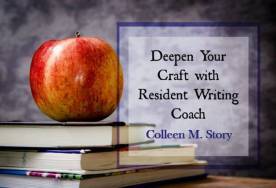
By Colleen M. Story
���There���s no such thing as writer���s block!���
No doubt you���ve heard this myth before.
Worse, you may have believed it.
And that���s rarely a good thing, as it tends to keep you where you are���in that stuck place you dare not call writer���s block.
Myth: There���s No Such Thing as Writer���s Block���There���s no such thing as writer���s block,��� says writer Leigh Shulman. ���It���s an excuse. Your way of telling yourself you have a reason for not writing.���
You���ll find a wide variety of writers echoing this same sentiment. Whenever I heard it, I worried. I didn���t want to be one of ���those��� writers.
���The secret about writer���s block is that it���s an indulgence,��� writes Amy Alkon for Psychology Today. ������The way you end so-called ���writer���s block��� is simply by sitting down to write���’blackening pages,��� as Leonard Cohen called it.���
Lazy! Undisciplined! We hear it again and again. Stop coddling yourself. Sit down and write!
I vowed to do just that. I wouldn���t be weak. I would be a strong, productive writer.
No writer���s block here.
Then along came my third novel, The Beached Ones. And it humbled me in a hurry.
My Novel Taught Me All About Writer���s Block
Draft after draft, I came up against a wall. No matter how hard I tried or how many hours I put in, I could not figure out how to get past the midpoint of that novel.
Now understand: I was no newbie to the mid-novel struggle. I had gone through it with my other two published novels, but never to this extent.
I bought books. I went to conferences. I talked to award-winning writers. I sketched out the plot. I outlined the chapters. I examined each of the character’s inner and outer motivations.
I did everything you should do when experiencing writer���s block���things that before had led to a breakthrough���and nothing helped.
It was frustrating, to say the least.
I looked writer���s block squarely in the eye and withered. So much for strength and discipline. They weren���t helping me at all.
My Cure for Writer���s BlockI finally had to admit that I was suffering a bad case of writer���s block.
Oh, the shame!
I���ve since learned that other writers���much as they may lecture about there being no such thing as writer���s block���just have a slightly different definition of it.
Says Schulman: ���Here’s the thing: Every writer who has ever existed feels stuck at some point. That’s why I say there’s no such thing as writer’s block because it’s part of the writing process.���
Oh. So it is writer���s block. You���re just calling it something else.
And that something else is comforting, isn���t it? Shulman is assuring us that everyone experiences being stuck now and then. Relax. It���s normal.
But I couldn���t relax. The story sat in the back of my mind bugging me day in and day out.
So I kept trying. And now, looking back, I can say that is my solution to writer���s block that I want to share with you: keep trying.
It is the key to finally breaking through.
The Key to Ending Writer���s BlockWhat does it mean to keep trying?
Don���t Give UpFirst of all, don���t give up on your story. I thought about it many times, but looking back, I���m really glad I didn���t. (The book is releasing soon, after all!)
Keep the Story In MindSecond, keep the story in mind.
Personally, I didn���t have any choice. The story wouldn���t leave me alone. It may be the same for you. But it also helps to find other ways to keep it at the forefront of your thoughts.
Everything I did along the way���starting over, reading books, attending workshops, outlining, researching, sketching, etc.���helped keep the story in my brain. My brain, in turn, continued to work on a creative solution to my writer���s block.
You don’t want to forget what was happening in your story. Even if you’re not writing new scenes and chapters, it’s important to keep the characters alive in your head in some way that you continue to “live” with them in their world.
Find a Way to Think Outside the BoxThis is what finally led to a breakthrough for me.
It was as simple as going to a movie.
I went to see Girl on a Train starring Emily Blunt. (Love her!) I was fascinated by how the story was told.
For much of the movie, the main character didn���t know what had happened to put her into her current situation.
It was something I had never explored before: what if my hero was in the dark as to what had happened?
Voila! Breakthrough.
That single idea was enough to send me back to the keyboard. And telling the story from that point of view solved my problem.
No more writer���s block. I sailed through to the end, put the book through several more rewrites, submitted it, and landed a publisher on���get this���April Fool���s Day, 2020.
For you, it’s likely to be something else (besides a movie) that allows you to break through your writer’s block. Maybe it’s an image you see, something you hear, or something someone says.
Here���s a tip: Usually, breakthroughs happen when we step away from our usual routines. Do something different, put yourself in a new environment, and allow your creative brain to play. That���s the best way to inspire it to come up with a solution.
See Writer���s Block as a Gift
Looking back, I can see that writer���s block gave me a gift���it forced me to come up with a more creative way to tell the story. It also taught me that you can be seriously blocked and still succeed in telling a good story if you���re willing to stick with it.
Shulman agrees that sometimes, being blocked can be a blessing:
“When you’re stuck, it’s often because you’re doing something you’ve never done before. That means you’re stretching yourself as a writer. You’re improving, and soon enough you will breakthrough to a new level. You’ll be a stronger, more agile, better writer.”
Writer���s block? It���s no myth, but if it���s plaguing you, it���s nothing to be ashamed of.
Instead, celebrate. Welcome your confusion. Allow your frustration. Bang your head against the wall and keep going.
If the story matters, you���ll find a way.
Note: The Beached Ones is forthcoming from CamCat books in June 2022. Get your FREE excerpt here, or preorder now! (Links and book trailer here.) Get FREE chapters of Colleen���s books for writers here.
 Colleen M. Story
Colleen M. StoryResident Writing Coach
Colleen M. Story inspires writers to overcome modern-day challenges and find creative fulfillment. Your Writing Matters helps writers overcome self-doubt and determine where writing fits in their lives. Writer Get Noticed! was the gold-medal winner in the Reader���s Favorite Book Awards. Overwhelmed Writer Rescue was named Book by Book Publicity���s Best Writing/Publishing Book in 2018, and her novel, Loreena���s Gift, was a Foreword Reviews��� INDIES Book of the Year Awards winner. Find out more at these sites:
Writing and Wellness | Life and Everything After | Teachable | Author Website | Twitter
The post The One Popular Myth Writers Believe About Writer’s Block appeared first on WRITERS HELPING WRITERS��.
April 5, 2022
Phenomenal First Pages Contest
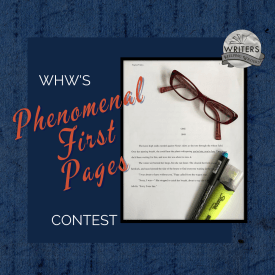 Hey, wonderful writerly people! It���s time for our monthly first-page critique contest
Hey, wonderful writerly people! It���s time for our monthly first-page critique contest 
If you���re working on a first page (in any genre except erotica) and would like some objective feedback, please leave a comment. Any comment :). As long as the email address associated with your WordPress account/comment profile is up-to-date, I���ll be able to contact you if your first page is chosen. Just please know that if I���m unable to get in touch with you through that address, you���ll have to forfeit your win.
Two caveats:
 Please be sure your first page (double-spaced in 12-point font) is ready to go so I can critique it before next month���s contest rolls around. If it needs some work and you won���t be able to get it to me right away, let me ask that you plan on entering the next contest, once any necessary tweaking has been taken care of. Resources for common problems writers encounter in their opening pages can be found here.
Please be sure your first page (double-spaced in 12-point font) is ready to go so I can critique it before next month���s contest rolls around. If it needs some work and you won���t be able to get it to me right away, let me ask that you plan on entering the next contest, once any necessary tweaking has been taken care of. Resources for common problems writers encounter in their opening pages can be found here.
 This contest only runs for 24 hours, start to finish, so get your comment in there!
This contest only runs for 24 hours, start to finish, so get your comment in there!
Three commenters��� names will be randomly drawn and posted tomorrow morning. If you win, you can email me your first page and I���ll offer my feedback.
We run this contest on a monthly basis, so if you���d like to be notified when the next opportunity comes around, consider subscribing to our blog (see the right-hand sidebar).
Best of luck!
PS: If you want to amp up your first page, grab our helpful First Pages checklist from One Stop for Writers. And for more instruction on these important opening elements, see this Mother Lode of First Page Resources.The post Phenomenal First Pages Contest appeared first on WRITERS HELPING WRITERS��.
April 3, 2022
Fear Thesaurus Entry: Growing Old
Debilitating fears are a problem for everyone, an unfortunate part of the human experience. Whether they’re a result of learned behavior as a child, are related to a mental illness, or stem from a past wounding event, these fears influence a character’s behaviors, habits, beliefs, and personality traits. The compulsion to avoid what they fear will drive characters away from certain people, events, and situations and hold them back in life.
In your story, this primary fear (or group of fears) will constantly challenge the goal the character is pursuing, tempting them to retreat, settle, and give up on what they want most. Because this fear must be addressed for them to achieve success, balance, and fulfillment, it plays a pivotal part in both character arc and the overall story.
This thesaurus explores the various fears that might be plaguing your character. Use it to understand and utilize fears to fully develop your characters and steer them through their story arc. Please note that this isn’t a self-diagnosis tool. Fears are common in the real world, and while we may at times share similar tendencies as characters, the entry below is for fiction writing purposes only.
 Fear of Growing Old
Fear of Growing OldNotes
While growing old is a natural part of life, it’s not always an easy process. Someone who has always looked young, whose identity is tied to their attractiveness, or whose occupation relies on their mobility and independence can develop a fear in this area. Whether they’re triggered by their changing looks, a potential mental decline, a physical weakening of the body, or death itself, someone with this fear may become driven to do everything in their power to keep the inevitable at bay.
What It Looks Like
Incessantly working out
Eating healthy
Following a strict and involved skin care regimen
Investing in multiple cosmetic surgeries
Wearing a lot of makeup to cover signs of age
Staying out of the sun
Seeing doctors often for preventative and corrective measures
Avoiding doctors altogether (being in denial about growing old)
The character hanging out with people younger than them
Adopting youthful practices, speech, and activities
Needing constant reassurance about their appearance
Being obsessed about staying physically and mentally active
Avoiding reminders of old age, such as nursing homes or a retirement party
The character constantly testing their mental or physical acuity to see if it has deteriorated
The character avoiding having their picture taken
Taking many supplements that support memory and improved neurological functions
The character comparing themselves to others their age
Remaining stubbornly autonomous; turning down help or refusing to admit that an activity is beyond the character’s ability
The character refusing to change their ways���e.g., continuing to drive even when it’s dangerous for them to do so
Heightened awareness of mental and physical changes over time causing the character to hide or compensate for them
Common Internal Struggles
The character obsessing over changes in their appearance or mental capabilities
Worrying that others also notice the changes
Seeing deficiencies where there are none
Constantly wanting to look in mirrors but being afraid of what will show up there
The character comparing themselves to others and finding themselves lacking
Becoming deeply insecure about their appearance
Knowing that aging is a normal (and unavoidable) process but feeling compelled to fight it anyway
Being in denial about changes that are happening
Hindrances and Disruptions to the Character’s Life
The character spending too much money to maintain their appearance, purchase supplements, etc.
Frequent surgeries and recoveries stealing the character’s free time
The character spending so much time on the activities that will keep them young that they pass up other opportunities
Difficulty relating to people their own age
Being exhausted by the effort to always prove themselves and their capabilities to others
Scenarios That Might Awaken This Fear
A friend or associate passing away
Seeing a drastic change in an older friend’s appearance
The character experiencing a physical change associated with aging, such as gray hair, age spots, or a drop in metabolism or libido
Hitting a milestone birthday (40, 50, 60, etc.)
The character having memory problems that aren’t caused by their age (a side effect of medication, not getting enough sleep, etc.)
The character having trouble doing something they’ve always excelled at
The character being rejected or discriminated against and believing it’s due to their age
Other Fear Thesaurus entries can be found here.
 Need More Descriptive Help?
Need More Descriptive Help?While this thesaurus is still being developed, the rest of our descriptive collection (16 unique thesauri and growing) is accessible through the One Stop for Writers THESAURUS database.
If you like, swing by and check out the video walkthrough for this site, and then give our Free Trial a spin.
The post Fear Thesaurus Entry: Growing Old appeared first on WRITERS HELPING WRITERS��.
March 31, 2022
Using Vocal Cues to Show Hidden Emotion
 “My Precious”
“My Precious”By Becca Puglisi
Any Tolkien fans in the house? I remember, as a teen, reading The Hobbit by the fire on a rare cold evening in Florida. It became a favorite that I would re-read until my copy literally fell to pieces.
One of my favorite scenes comes right at the beginning: the Unexpected Party. There are a lot of reasons it works so well���one of which is everything Bilbo is not saying. When the dwarves arrive (and keep arriving), he wants to know what they���re doing there, but instead of asking, he puts on his Happy Homemaker face and gets to work being hospitable. As it gets late, he doesn���t show them the door. He refrains from telling Thorin to get off his high horse and show some gratitude for Bilbo funding his little reunion, though you know that���s what he���s thinking.
The interactions between Bilbo and the dwarves ring true precisely because of all the subtext���the contrast between what the character says and what he���s really feeling or thinking. This subtext is a normal part of most real-life conversations; for this reason alone, it should be included in our characters��� conversations. But it���s also useful because whenever a character is hiding something, there���s inherent emotion involved. Emotion is good for our stories because well-written, clearly conveyed character feelings will often engage the reader���s emotions, pulling them deeper into what���s happening. So subtext is good on a number of levels.
But writing hidden emotion is challenging. Authors have to show the character portraying one emotion to the cast (pleasure, in Bilbo���s case) while showing his true feelings to the reader (confusion, frustration, and indignance). It���s a tall order, but this is where vocal cues can come in handy.
Vocal cues are shifts in the voice that happen when someone is feeling emotional. While we may be able to hide our feelings by masking our facial expressions and minimizing certain body language giveaways, the voice is harder to control. In a written scene, these vocal fluctuations act like signposts, leading the reader to the conclusions you want them to draw about the character���s true emotional state.
So when you need to show that a character is hiding their feelings from others, consider the following vocal cues.
 Pitch
PitchDoes the voice get high and shrill or go low and rumbly?
VolumeDoes the character move from a moderated level to almost yelling? Does the voice drop to a near whisper? Is it clear that they���re struggling to maintain a reasonable volume?
Does a clear tone turn breathy or husky when someone is aroused? When the character is close to tears, does the voice become brittle or cracked? Does it lose all expression and become flat when anger hits?
Does your verbose character suddenly clam up? Does her timid, verbally stumbling counterpart start running at the mouth? Might poor grammar appear in a well-educated character���s dialogue? Does a stammer or lisp announce itself?
What words might slip into a character���s vernacular when they���re feeling emotional that they wouldn���t normally use? Profanity and slurs? Words and phrases from their first language? Pat clich��s?
Nonspeech InterruptionsWhat sounds begin to pepper your character���s dialogue? Um, Hmm, Uhhh, throat clearing, and coughing can be signs that the character is uncomfortable and needs time to pull him or herself together.
For your character, consider which of these cues might be a possibility, then write it into the story when their emotion changes. Used consistently, they���ll signal the reader that the character is hiding something or that a certain emotion is in play.
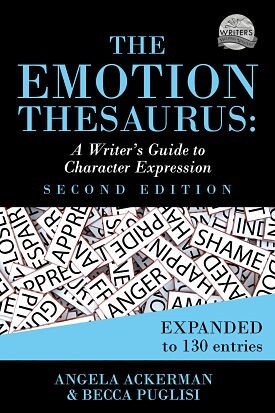
Granted, for this to work, you need to first establish a baseline. Figure out your character���s normal speech patterns and habits and write those consistently so readers will get used to them. Then, when a vocal cue is used, they���ll know to take a closer look to see what the character is hiding.
For more information (and a handy reference), see our Deception in Dialogue Tip Sheet at One Stop for Writers.
And check out the 2nd edition of The Emotion Thesaurus: A Writer’s Guide to Character Expression , which is a treasure trove of information on how to show exactly what your character’s feeling���even when they want to keep it hidden.
What vocal cue might work well for your character? What cues have you seen successfully used to hint at hidden emotion? I���d love to hear from you.
The post Using Vocal Cues to Show Hidden Emotion appeared first on WRITERS HELPING WRITERS��.
March 28, 2022
Setting Description Mistakes that Weaken a Story

When you think about the key elements of storytelling, characters and plot immediately come to mind, but what about the setting? Do you view it as 1) a vital story component, or 2) just the place where story events happen?
If you picked 1, nice job. If you picked 2, no worries. Go here, scroll down, and buckle in. Reading through these setting articles will transform the way you view the setting.
The setting tied to each scene carries a lot of storytelling weight because it had the power to touch and amplify anything to do with characters, events, and emotion. Used correctly, a location can characterize the story���s cast, steer the plot, evoke emotions and mood, create windows to allow for active backstory sharing, provide conflict and challenges, and act as a mirror for what the protagonist needs most, reinforcing his motivation at every step.
When it comes down to it, the setting is storytelling magic. What other element can do so much to enhance a story?
Here are five mistakes with settings that can drain power from your story.1) Treating The Setting Like Stage Dressing
Each setting holds great power, deepening the action as it unfolds and characterizing the story���s cast during the scene. If we only use a few words to summarize the location, it can really impact the reader���s ability to connect with the characters and what���s happening. Vivid, concrete details not only help readers feel like they���re right there, planting specific description and symbolism within the setting also adds layers to the story itself.
2) Focusing On Only One Sense

Another common struggle for writers is choosing to describe through a single sense, specifically sight. While we rely heavily on this sense in real life, our world is multisensory, and our job as writers is to make our fictional landscape as rich and realistic as the real thing.
We want to make each scene come alive for readers so they feel like they are right there next to the protagonist, experiencing the moment as he or she does. This means including sounds which add realism, smells which trigger the reader���s emotional memories and help create ���shared experiences,��� tastes that allow for unique exploration, and textures that will shed light on what���s important to the character through their emotional state.
Textures are especially critical to include, as a point of view character must directly interact with the setting to bring it about, and every action in the story should have purpose. What they touch should have a ���why��� attached to it, revealing the POV character���s mindset, and showing, rather than telling, readers what���s really important in the scene.
3) Over-Describing Or Describing The Wrong Things
Sometimes in our enthusiasm to draw readers into the scene, we go a little crazy when it comes to describing. Trying to convey every feature, every angle, every facet of the setting will not only smash the pace flat, it will likely cause the reader to skim. And, if they skim, they are missing all that great description you���ve worked so hard to include. So, to avoid over-describing or focusing on the wrong details, try to make each bit of description earn the right to be included.
It isn���t just about showing the scene���the weather, the lighting, the colors and shapes���it���s also about offering detail that does double duty somehow. Ask yourself, is the detail I want to include doing something more than showing the reader where the characters are? Is it also characterizing, evoking mood, reminding the POV character of his goal and why he wants it so bad? Is this detail creating a challenge in some way, standing between the character and his goal? Is it helping to convey his emotional state, or does it symbolize something important within the context of the story?
Setting description should always be adding to the scene, revealing more about the characters as it helps to push the story forward.

4) Not taking Advantage of POV & Emotion Filters
Another area that can water down the effect of setting description is a very distanced narrative where every detail is explained, rather than shown through the emotional filter of the POV character. A character who is anxious is going to view the sights, sounds, smells, tastes, and textures of any given setting differently than a character who is excited, or disappointed, or even filled with gratitude.
Being able to filter the character���s world through their senses and emotions helps to pull the reader close to the character, and creates a deeper understanding of who they are, laying the groundwork for empathy.
5) Choosing A Setting That Is Convenient Rather Than Meaningful
Because the setting can steer the story, evoke emotion, remind the hero or heroine of missing needs and create a window into past pain, we need to get specific when we choose a location. Three questions to ask ourselves as we hunt for the perfect place is 1) what is the outcome of this scene, 2) how can I use the setting to generate conflict and tension (good or bad) to really amp up what is about to take place, and 3), how can I create an emotional value in this setting?

Emotional values���settings which mean something to one or more characters��� are especially important. For example, imagine a character who is about to be interviewed for an important job. He���s confident because he���s got the skills they need, and the experience this company covets. His potential employer decides on an informal lunch interview, and our character is eager to impress. A restaurant setting makes sense���but why would we choose just any old restaurant for this scene to take place? Instead, let���s pick the very same restaurant where our character proposed to his girlfriend two years earlier and was rejected. By having this interview take place in this particular restaurant, we have created an emotional value���it represents something to the character: rejection.
Choosing this restaurant will put our character off balance, and the echoes of his past failure will be with him during the interview. This will almost certainly affect his behavior, creating tension and conflict. Will he get the job? Will he blow the interview? The outcome is now uncertain. Take the time to choose the best location for each scene, because the storytelling currency will be well worth the effort!
The setting is a powerful component to storytelling, but only if we fully activate it. So when you choose a setting, consider carefully how the right location can amp up the tension and point the reader’s attention to the very things you want them to notice, be it a symbol in your setting, your character’s behavior because the setting is activating their emotions somehow, or a danger or obstacle tied to the setting that’s about to challenge your character and disrupt their progress to their goal.
 Brainstorm the best location for each scene
Brainstorm the best location for each sceneIf you need inspiration as you choose the right setting and would like a list of ideas on how to describe different places using sensory language, swing by the Setting Thesaurus Database at One Stop for Writers. Each setting in the database also has a list of possible conflicts that might take place in that location, helping you think about how to make things harder for characters.
The post Setting Description Mistakes that Weaken a Story appeared first on WRITERS HELPING WRITERS��.
March 26, 2022
Fear Thesaurus Entry: Conflict
Debilitating fears are a problem for everyone, an unfortunate part of the human experience. Whether they’re a result of learned behavior as a child, are related to a mental illness, or stem from a past wounding event, these fears influence a character’s behaviors, habits, beliefs, and personality traits. The compulsion to avoid what they fear will drive characters away from certain people, events, and situations and hold them back in life.
In your story, this primary fear (or group of fears) will constantly challenge the goal the character is pursuing, tempting them to retreat, settle, and give up on what they want most. Because this fear must be addressed for them to achieve success, balance, and fulfillment, it plays a pivotal part in both character arc and the overall story.

This thesaurus explores the various fears that might be plaguing your character. Use it to understand and utilize fears to fully develop your characters and steer them through their story arc.
A Fear of ConflictNotes: Disagreements happen, and while most of us don’t like confrontation, we understand we need to face these moments of friction and try to resolve them. But for some, the threat of conflict sparks such heightened anxiety a person will do anything in their power to avoid it. As you can imagine, characters who fear conflict will struggle in the story because it is something they face again and again on the path to their goal. (For a list of conflict scenarios to use in your story, go here.)
What It Looks Like
Being a people-pleaser
Holding back
Being highly agreeable
Lying when someone asks if something’s wrong (telling them it’s fine)
Not complaining
Putting up with problems rather than bother others for help addressing them
Avoiding certain topics when in a conversation
Changing the topic when things are getting heated between others
Avoiding people who are aggressive and outspoken
Being highly proactive or over-prepared (so nothing will go wrong)
Tentative questions
Finding it almost impossible to say No
Being unhappy or dissatisfied but not voicing it (not saying anything about an undercooked meal at a restaurant, for example)
Not returning things that are broken or under warranty
Putting up with annoyances rather than asking someone to stop
Always giving in
Accepting blame when it isn’t deserved
Apologizing
Letting others have their way
Letting others take the credit
Working harder to make up for another’s deficiency (laziness, a lack of knowledge, poor management skills, etc.) rather than talk to them about it
Not rocking the boat
Telling people what they want to hear
Echoing popular opinions if asked
Coming across as overly nice
Withdrawing or becoming quiet when others are upset
Being a perfectionist
Not self-advocating
Letting other people make the decisions
Being unable to lead effectively
A lump in the throat, causing visible swallowing
Feeling on the verge of tears if confronted
A shaky voice
Backing away from people who are emotionally activated
Collapsed shoulders; taking up less space when threatened
Common Internal Struggles
Wanting to escape when a confrontation happens
Worrying about whether something they are doing is annoying others
Resenting people for the things they do that make life harder instead of asking them to change
Thinking about the worst case scenario
The character putting their needs last
Self-directed anger after a confrontation for not self-advocating or standing up for what was right (sabotaging self-esteem)
Being uncertain in the moment
Struggling to manage heightened anxiety symptoms and just wanting to flee
Hindrances and Disruptions to the Character’s Life
Becoming overburdened because others take advantage of their inability to say no
Being viewed as timid and weak by others
Having people in their life that they don’t really like because they can’t take steps to sever the relationship
Being taken advantage of by others (who may not even realize they are doing so)
A lack of assertiveness keeping the character on the sidelines at work
Becoming burnt out
Doing what others want, not what they want
Personal dreams and goals being put on hold
Problems that grow and lead to dysfunctional situations that will eventually explode
Scenarios That Might Awaken This Fear
Receiving criticism (even when it’s constructive)
Being asked to weigh in, especially during a heated exchange between others
When the character is late or there’s a delay that will be noticed by others
Disagreements in relationships
Arguments and yelling
When the character makes a mistake or can’t follow through (even when there’s a legitimate reason)
Being asked to lead
Having to deliver bad news
Having to raise a complaint, follow through on a warranty claim, or return something to a store
When someone is angry or frustrated around the character
Other Fear Thesaurus entries can be found here.
 Need More Descriptive Help?
Need More Descriptive Help?While this thesaurus is still being developed, the rest of our descriptive collection (16 unique thesauri and growing) is accessible through the One Stop for Writers THESAURUS database.
If you like, swing by and check out the video walkthrough for this site, and then give our Free Trial a spin.
The post Fear Thesaurus Entry: Conflict appeared first on WRITERS HELPING WRITERS��.
Writers Helping Writers
- Angela Ackerman's profile
- 1014 followers



